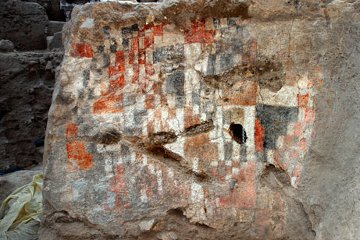Sophisticated Primitives
The astonishing Neolithic city of Catal Hüyük in Turkey has long been known for its beautiful pottery and its complex housing arrangements. French archaeologists of the Centre National de Recherche Scientifique, working in northern Syria, have uncovered what may be the world's oldest house painting.
Directed by Eric Coqueugniot, the team has been working at Djade al-Mughara, where they have uncovered a Neolithic settlement whose inhabitants do not appear to have practised argriculture, but instead lived as hunter-gatherers. Mind you, why would anyone go in for the hard life of a farmer if the pleasures of the chase were all they needed for sustenance? It would be a mistake to assume that the lack of agriculture indicated that these people were primitive or unsophisticated - and the painting appears to bear this out.

| |
| The chequer-board pattern of Djade al-Mughara |
What the archaeologists have found is an underground circular room 20' in diameter with a single pillar in the centre to support the roof poles. The pillar and the walls were decorated with a geometric pattern of squares that reminded some of the team of the modern painter Paul Klee, though less artistic members dubbed it a "chequer board". The colours are red from crushed haematite, black charcoal and white lime. By conventional chronology, the painting is 11,000 years old - 1,500 years older than the wall paintings discovered in Catal Hüyük.
The size of the room as well as its underground location suggested to the excavators that it was not a domesetic building but had a ritual use and they have come up with a wonderful theory about how a chequer board "marks the borders of the spiritual realm within a world-view that is cosmologically defined".
Personally, I am happy to consider that the room may indeed have had a ritual purpose. People commonly went to considerable lengths to beautify their places of worship. I doubt, however, that the pattern had any importance other than the aesthetic and it is just as likely to reflect a desire not to depict any figure that could be worshipped. An abstract pattern would not "make an image of anything in heaven above nor in the earth beneath nor in the waters under the earth", to quote the Second Comandment of the Decalogue."
Work is continuing at the site, where a large number of flint implements and weapons have been found. The people appear to have buried their dead beneath the floors of their houses - perhaps to save them from being dug up by wild animals. Other decorated surfaces have been identified, but the work of excavation and preservation is very slow, as mud plaster is not the most stable of surfaces after such a long period of time.





